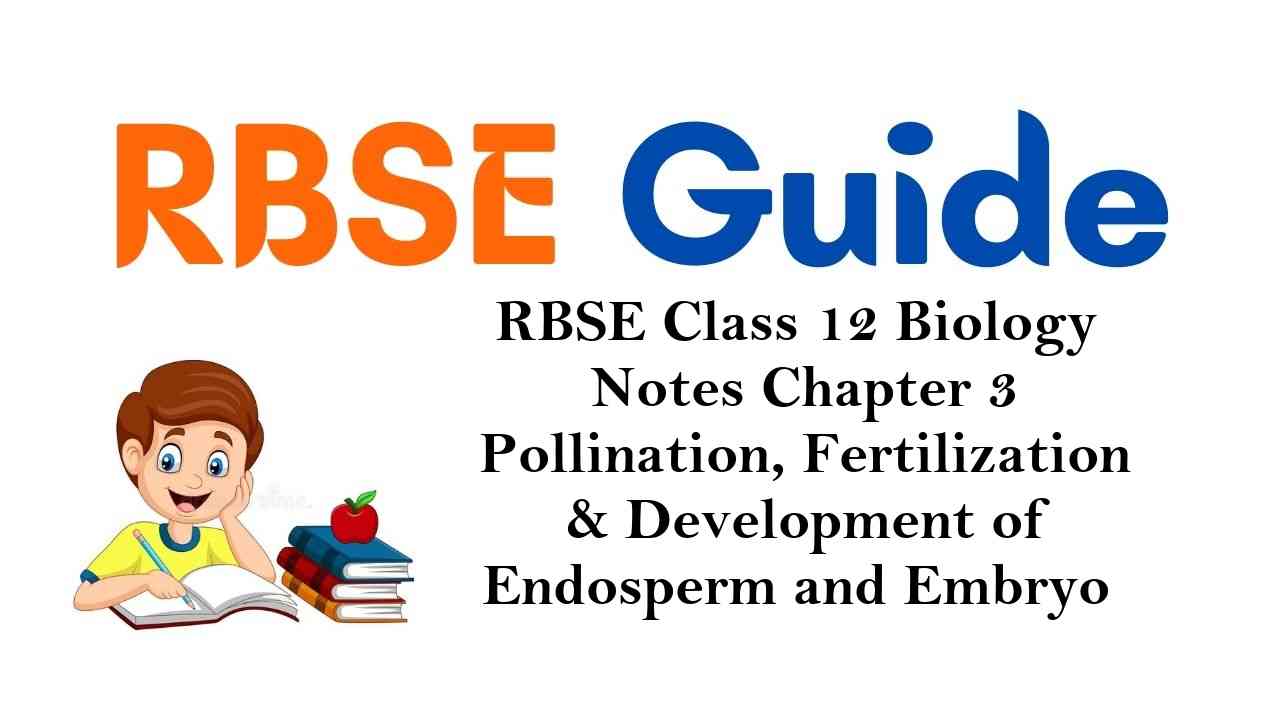Rajasthan Board RBSE Class 12 Biology Notes Chapter 3 Pollination, Fertilization & Development of Endosperm and Embryo
Pollination
Definition :
Pollination is defined as the process of transfer of pollen grains from an anther to the stigma of the same flower or of different flower.
For pollination, release of pollen grains from pollen sac is must. Pollination can occur by different agencies such as through insects, air. water, birds, bat, snails or ants etc.
Types of Pollination :
(A) Self Pollination
(B) Cross-Pollination
(A) Self Pollination:
If the pollen grains are transferred from an anther to the stigma of the same flower or on different flower on the same plant then this process is called Self pollination.
It is of two types :
- Autogamy : Pollen grains transferred to stigma of same flower means flower is pollinated by its own pollen grains. Example – Pea.
- Geitonogamy : Pollen grains of a flower are transferred to stigma of a different flower on the same plant. Thus pollination occurs between two flowers present on the same plant.
From genetical point of view’ geitonogamy is equivalent to self-pollination because all flowers on a plant are genetically identical but from ecological point of view, the botanists consider it as cross-pollination. Example : Maize, Cucumber.
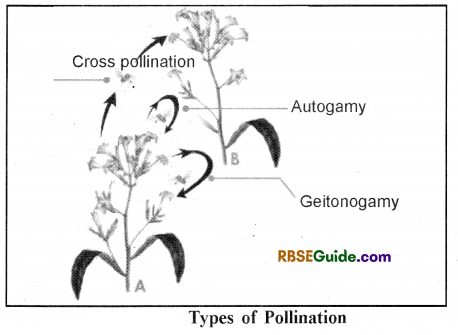
For self pollination, following adaptations are found in plants.
- Bisexuality : Plants are either hermaphrodite or with bisexual flower so that self pollination can take place. Example : Pea
- Hoinogamy : Both sex Organs of a flower mature at the same time. At the time of dehiscence of pollen sac. stigma is receptive so that there is 100% chance of successful self pollination. Example – Mirctbilis, Catharcin thus.
- Cleistogamy : Flowers of some plants never open and they remain closed so there is possibility of only self-pollination. Example-Viola, Commelina etc.
![]()
(B) Cross Pollination/Allogamy:
When pollen grains are transferred to stigma of the flower on different plant it is called Cross-pollination or Allogamy.
Types of Cross Pollination :
- Xenogamy : Pollen grains of a flower arc transferred to stigma of a different flower on a different plant of same species.
- Hybridism : Pollen grains of a flow’er are transferred to stigma of a flower of a plant of different species.
Contrivances or Adaptations for Cross Pollination
Following contrivances or adaptations always promote cross-pollination:
(A) Self sterility or Incompatibility : In this condition the pollen grains of the same flower camrot fertilize their own ovules even though there are favourable conditions and so they do not germinate on stigma of same flower e.g. Passiflorct, Malva, Potato, Vitis, Petunia etc.
(B) Unisexuality or Dicliny : In unisexual flow ers stamens and carpels are found in different flowers. Unisexuality can be of two type :
- Monoecious : When male and female flowers are borne on the same plant
e.g. Maize, Cucurbita, Castor. - Dioecious Plants : When male and female flowers are borne on different plants
e.g. Carica papaya. Cannabis sativa.
(C) Dichogamy : In many hermaphrodite or bisexual flowers stamens and carpels of a flower do not mature at the same time. Dichogamy is of two types.
- Protandry: The anthers of a flower mature earlier than carpels eg.Jasminum, Foeniculum, Tagetus, Sunflower.
- Protogyny: The carpels of a flower, mature earlier than stamens e.g. Ficus benghalensis Polyalhia, Anona, Michelia, Rose.
![]()
(D) Herkogamy : In some homogeneous flowers there are some adaptations due to which self pollination cannot occur. These adaptations ar.e as follows : In caryophyllaceous flowers the stigma projects beyond the stamens so that pollen do not fall on it, conversely in Gloriosa they dehisce at a distance so that stigma is out of reach to its own pollen.
(E) Heterostyly: The flowers may be of two or more types with regard to the length of the style and length of stamens and hence pollen from a flower cannot bring about effective pollination in flowers of its own type e.g. Oxalis, Lythrum, Primula.
Methods of Cross Pollination :
The agencies which transfer pollen grains from anthers of one flower to the stigma of a different flower are as follows: Wind (Anemophily), Water (Hydrophily), Insects (Entomophily), Birds (Omithophily) and Bats (Cheiropterophily).
1. Anemophily: Anemophilous or wind pollinated flowers produce enoromous amount of pollen grains. These plants bear small and inconsipicous flowers. The pollen grains are small, light, smooth and dry. Pollen of some plants are said to be blown to 1,3000 km.
In some plants pollen grains are winged, e.g., Pinus, in some, flowers are very long. Anemophilous flowers have adequate devices to catch the air bom pollen grains with utmost efficiency. For this the stigma is usually large and feathery (as in grasses) and brush like as in Typha.
2. Hydrophily : When pollen grains are transferred by water it is called hydrophily. Not all aquatic plants arepollinated by water. For example Potamogeton and Myriophyllum by anemophily and Nymphea by entomophily.
![]()
Hydrophily is of two types :
- Hypohydrophily : Includes plants which are pollinated inside the water e.g. Najas, Ceratophyllum, Zostera etc.
- Epihydrophily: When pollination of flower is on surface of water, it is called epihydrophily Example : Vallisneria.
3. Entomophily : Some of the insects which help in pollination are bees, flies, wasps, moths and beettles. Bees probably carry about 80% of the pollination done by insects. These flowers are coloured possess special smell and/or produce nectar. Pollen grains are sticky with spinous exine. Some examples of insect pollinated plants are : Mustard, Salvia, Orchids, Aak tree.
4. Ornithophily : Some plants are pollinated by birds. Flowers are attractive with nectar. Tiny birds like humming birds and honey thrushes feed on the nectar of flowers like Bigonia Erythrina is visited by crow. Pollengrains stick to beak and body of birds and reaches to another plant. Some other birds involved in pollination are sunbird and Nectarina. Some examples of insect pollinated plants are Nicotiana, Callistemone (Bottle Brush), Ericaceae family, Bombax, Bigonia, Butea, Erythrina.
5. Cheiropterophily : Bat is nocturnal mammal which can fly and reaches to flowers for nectar and insects. Flowers of some plants open in night and secrete more amount of nectar. Bat is helpful in pollination of these plants. Example, Anthocephalus, Bauhinia, Kigellia, Adansonia etc.
Some plants like Arisaema and some orchids are pollinated by snails. Squirrels are also involved in pollination of Gulmohar plant.
Incompatibility
Failure of fertilization between functional and fertile male and female gamete is called incompatability. It is of two types.
(i) Interspecific : When incompatibility is between members of two different species belonging to same genus.
Example : Brassica campestris : Brassica rapa.
(ii) Intraspecific : When incompatibility is between members of same species that is called self incompatibility or self sterility. Example Primula.
Pollen-pistil Interaction : This interaction leads to incompatibility in plants. The reasons may be physiological or morphological. These are controlled by multiple alleles of a gene. Generally it develops at the time of maturity of stigma and at the time of formation of wall of pollen grains.
Self incompatibility or self sterility if is determined by male gametophye or by pollen grain then it is called gametophytic incompatibility and if sporophytic tissue determines incompatibility then it is called sporophytic incompatibility.
![]()
Reasons of Incompatibility in Plants
- The pollen may fail to germinate.
- The pollen tube fails to grow.
- The pollen tube may fail to reach proper place.
- The pollen tube may bust in the style’region.
- The male and female gametes may fail to fuse.
Fertilization
Fertilization involves the fusion of male gamete with female gamete. It was first studied by Strasburger (1884), in Li Hum sps. Fertilization can be studied under following headings.
(A) Germination of Pollen grains and Growth of Pollen tube :
By pollination, pollen grains reach to stigma where the germination starts. On the surface of stigma, various secretions such as fats, sugar, resins etc. provide ideal conditions for germination of pollen grains. The time taken by pollen from reaching to stigma and then its germination is called pollination time.
Generally at the time germination, intine grows out of genu pore and pollen tube grows through style and reach the ovules. The pollen grains are usually monosiphonous (i.e. develop one pollen tube) but some plants are polysiphonous i.e.. develop more than one pollen tube. Ex. – Cucurbitaceae and Malvaceae. No. of pollen tubes may be 10-14 but only one pollen tube remains functional. Length of pollen tube depends on length of style. Its length in maize is about 45.0 mm.
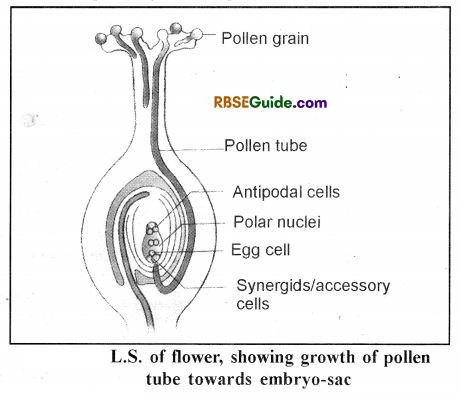
(B) Growth of Pollen tube
Growth of pollen tube depends on internal structure of style. Style is hollow in Liliutn and Ribes. Its cavity is filled with slimy substances which promote the growth of pollen tube. Style is solid or closed in most of the plants. In these plants by action of pectinase enzyme tissues present in central region gets destroyed and it results in formation of pathway in style. In some plants such as Oenothera.
Petunia, pollen tube passes through intercellular spaces present between cells. The pollen tube alw ays grows towards direction of ovule. Chemical factors present in style, ovary and ovule governs the direction of growth of pollen tube. It always grows towards ovule present in ovary7. It means growth of pollen tube is unidirectional and chemically controlled (Chemotropic).
![]()
(C) Entry of Pollen tube in the ovule :
The pollen tube may enter the ovule by three ways (Diagram)
- Porogamy : When Pollen tube enters into ov ule through micropyle. It is most common method found in plants.
- Chalazogamy When pollen tube enters into ovule through chalazal end. Example – Casuarina, Betula.
- Mesogamy : When pollen tube enters into ovule by penetrating through integuments. Example : Cuccurbita, Pop ulus.
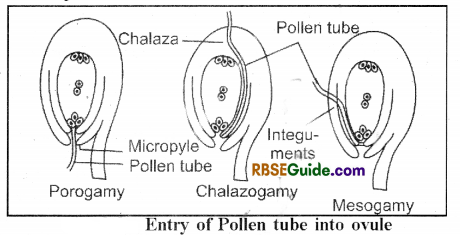
(D) Entry of Pollen tube in the embryosac
After entering the ovule the pollen tube passes through the nucellus and reaches the embryo sac. There are following ways through which pollen tube enters in embryo-sac.
- The apex of pollen tube may either pass between the egg and one synergid, or
- Between the embryo sac wall and a synergid, or
- Directly into synergid. As a rule one synergid is destroyed by the impact of the pollen tube and other synergid remains intact until sometimes afterwards.
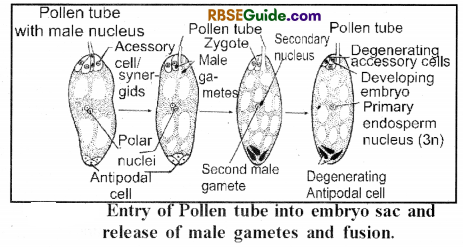
Different stages of movement of Pollen tube into Embryo sac
(1) One of the two synergids is already destroyed before the entry7 of pollen tube into embryo sac.
(2) Generally pollen tube enters between two synergids or accessory cells and after moving to some distance it passes through filliform apparatus of degenerated accessory cell.
(3) Two subterminal openings are produced, one gamete is discharged through each opening or the tip of the pollen tube burst at the apex releasing both male gametes.
(4) Out of two male gametes one reaches easily near egg cell and the second gamete reaches close to diploid
nucleus (Secondary nucleus) either by amoeboid or other movement.
Double Fertilization and Triple Fusion
After discharge from pollen tube one male gamete fuses with the egg and forms the oospore (zygote). This is called true fertilization or first fertilization (Syngamy = Amphimixis). The oospore is diploid (2n).
The second male gamete fuses with the secondary7 nucleus (2n) and forms a triploid (3n) nucleus called endosperm mother nucleus (Primary endosperm nucleus). This is called triple fusion. Thus both the male gametes participate in fertilization i.e. fertilization takes place twice. This is called double fertilization (Double fertilization includes syngamy as well as triple fusions).
Sometimes fusion of male gamete and secondary nucleus is called Second fertilization. Zygote produced, as a result of syngamy developes into embryo and the triploid nucleus (Endosperm mother nucleus / Primary endosperm nucleus) developes into the endosperm which is used for nutrition of embryo. Antipodals and synergids degenerate after fertilization.
![]()
Double fertilization was fu st studied by Nawaschin (1898) in Fritilaria and Lilium plants. Double fertilization is an important and unique feature of angiosperms. Besides angiosperms, this feature is not found in any other group. There is duration of 2 hours to 25 hours between pollination and fertilization. Triple fusion occurs before fusion of male and female gametes.
Significance of Double fertilization
One male gamete fuses with female gamete to form diploid zygote which on further development forms embryo. Second male gamete fuses with secondary nucleus to form triploid (3n) endosperm nucleus which develops to form endosperm. The endosperm supplies food material to the developing embryo and it is intial or primary source of nutrition to developing embryo. Required nutritive substances are present in embryo sac for development of embryo. Many plant embryologists believe that endosperm presents hybrid nature of both parents as it contains chromosomes of both male and female parent. Endosperm supplies food to developing embryo due to which the embryo is differentiated properly leading to the formation of viable seeds.
According to Brink and Cooper (1948) “The endosperm is a tissue developed to compensate for the extreme reduction of female gametophyte in angiosperms”. Both the syngamy and triple fusion are important for formation of a viable seed.
Note : It is important to note that in angiosperms, triple fusion results in the formation of a triploid nucleus known as primary endosperm nucleus. This act takes place during fertilization. The primary’ endosperm nucleus divides to form a triploid nutritive tissue called endosperm. The endosperm is formed after the act of fertilization and before the development of embryo begions.In gymnosperms the endosperm is a haploid tissue and is formed much before the act of fertilization.
Endosperm :
On the basis of development, endosperm in angiosperms is of three types :
(i) Nuclear endosperm : The primary endosperm nucleus divides repeatedly without wall formation. All the divisions are mitotic. Many nuclei are formed by free nuclear division. Nuclei arrange towards the periphery of the embryo sac and a large vacuole is formed in the centre. After sometime wall formation starts and it becomes cellular. 56% families of angiosperms have this kind of endosperm. Coconut water is an example of nuclear endosperm. There is liquid filled in endosperm in which many nuclei float. This is called liquid endosperm.
(ii) Cellular endosperm : The primary endosperm nucleus divides mitotically. The first and most of the subsequent nuclear divisions are accompanied by wall formation so that the embryosac becomes divided into several chambers. This type of endosperm formation is common in gamopetalae e.g. Villarsia, Adoxa.
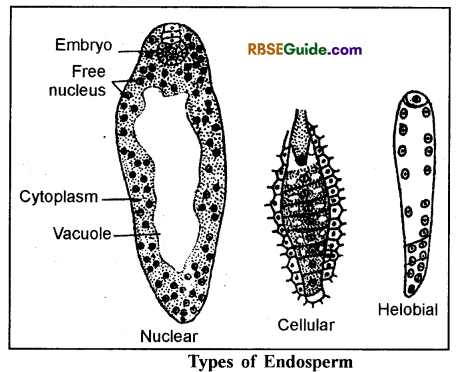
(3) Helobial endosperm : It is intermediate between nuclear and cellular type. The first division of endosperm mother nucleus is followed by wall formation forming two unequal cells, (a very large micropylar and small chalazal). Micropylar cell divides by free nuclear divisions later followed by wall formation. In the chalazal cell 1 or 2 divisions may takes place and it functions as small haustorial cell. Eg. Order Helobiales of monocot plants.
![]()
Functions of Endosperm :
(1) Cells of endosperm contain carbohydrates, fats and proteins as per plant species. These provide nutrition to developing embryo in initial stages. In some plants endosperm cells contain suckers through which these cells derive their nutrition from nearby cells. In endospermic seeds, endosperm provides nutrition to newly developed plantlets at the time of seed germination
Embryogenesis or Development of Embryo
1. Embryogenesis was first studied in Dicotyledonous plant of cruciferae family, Capsella bursa pastoris by Hanstein (1840). Here details of this is presented.
2. After syngamy the egg is called oospore (zygote). The first division of oospore is transverse. Of the two cells thus formed, the one which lies towards interior of embryo sac is called terminal cell (embryonal cell) and other as basal cell (suspensor cell). The terminal cell may divide vertically. The suspensor cell divides by several transverse divisions forming a 5-10 celled suspensor. The uppennost cell of this suspensor swells up to form a vesicular or haustorial cell.
The suspensor pushes the developing embryo into food laden endosperm and the upper cell functions as haustorium. The lowermost cell of suspensor is called hypophysis. This cell gives rise to the apex of radicle. The suspensor is destroyed after the formation of radicle. In the mean time two cells formed by vertical division of terminal cell.
Divide by a transverse division forming four embryonal cells (Quadrant stage). These four cells divide by another vertical division forming eight cells (Octant stage). Four cells at the apex (epibasal cells) give rise to plumule and cotyledons. Four cells in between the epibasal cells and suspensor, called hypobasal cells give rise to hypocotyl and most part of the radicle.
3. All cells of octant stage, divide by a periclinal division forming one layered outer (epidermal) cells which after anticlinal divisions form dermatogen. The inner cells (central cells) divide by several transverse and verical divisions forming plerome in the center and periblem in between plerome and dermatogen. Dermatogen gives rise to epidermis, periblem to cortex and plerome to vascular tissue. After several more divisions the embryo becomes cordate.
The cordate embryo differentiates in to two lobes which later develop in to two cotyledons. The part of axis or embryo situated between the two cotyledons gives rise to plumule. Thus in the mature embryo, the plumule is terminal and the two cotyledons are lateral in position.
In Capsella bursa pastoris and majority of dicotyledons, the mature embryo is differentiated into two cotyledons and the embryonal axis. The part of the axis, situated above the base of the cotyledons is called epicotyl and the part of axis situated below the base of the cotyledons is called hypocotyl. The radicle is situated at the terminal end of the hypocotyl. At the time of seed germination, the plumule gives rise to the shoot system and the radicle forms the root system. The food stored in the cotyledons is sufficient to establish the young plantlet.
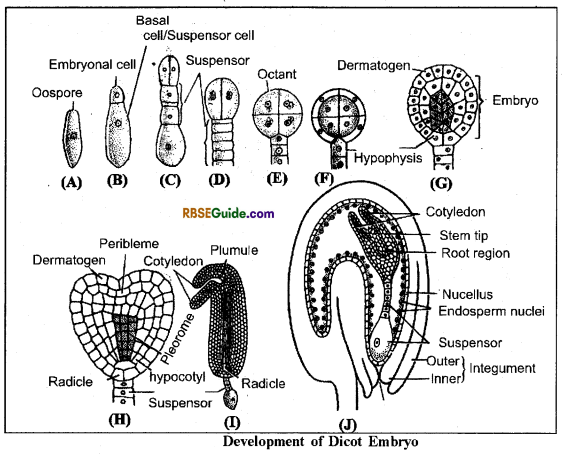
Development of Seed
After double fertilization the development of embryo and endosperm takes place in embryo-sac. Integuments of ovule (outer and inner) convert into seed coat. The outer integument becomes hard and forms testa and’the inner integument becomes thin and papery and is converted in to tegmen. The point of attachment of fiinicle to ovule is seen as a scar after detachment of seed from fruit wall.
There is no much change in hilum, micropyle, raphae and chalaza and these tissues mature. Nucellus is generally consumed at the time of endosperm development but in some plants such as Black Pepper nucellus is seen as thin film like structure, known as peris perm .
In some plants there is fleshy coating around ovule called as aril. In litchi edible part is aril. In some plants (Euphorbiacea) there is some whitish structure at micropylar end known as caruncle Example – Castor seed. In most monocot plants, there is plug like structure on micropyle known as operculum. On the basis of presence or absence of endosperm, seeds are of two types :
(i) Non – Endospermic or Exalbuminous seeds : In these seeds endosperm is used up by the growing embryo and is no longer seen in the mature seeds. Example – Most dicotyledonous plants such as pea, groundnut, gram. In such plants food is stored in cotyledons.
![]()
(ii) Endospermic or Albuminous seeds : In some seeds the endosperm is found as tissue around the developed embryo (Ricinus, Phoenix, Triticum) which persists unitl the germination of seeds. Example Monocot plants (Maize) and Castor etc.
Major Events that take place during formation of seed from ovule.
| S.No. | Part of Ovule | Part of Seed |
| 1. | Funicle | Stalk |
| 2. | Hilum | Hilum |
| 3. | Nucellus | Degenerate, sometimes present-called Peri sperm. |
| 4. | Integument | Seed coat (Testa and Tegmen) |
| 5. | Embryo sac | Degenerate and Sometimes present |
| 6. | Accessory cells / Synergids antipodal cells | Degenerate |
| 7. | Fertilized egg cell | Embryo |
| 8. | Secondary nucleus | Endosperm |
Development of Fruit
Fruit is a ripened ovary enclosing the seeds. The ovary wall developes into fruit wall. Due to synthesis of growth hormones, the ovary wall converts into pericarp. Fruit developed from ovary is known as “True fruit”. In some plants fruit developes from calyx, corolla or thalamus along with ovary then these fruits are known as “False fruit”. Sometimes ovary developes into fruit without fertilization, such fruits are known as “Parthenocarpic fruit” and the process as parthenocarpy. Example : Banana, Grapes, Papaya. In such plants, fruits do not have seeds. These days spraying growth hormones (Auxins and Gibberellins) on stigma can also lead to parthenocarpy. Such type of parthenocarpy is called induced parthenocarpy.
Alternation of Genaration
Life cyle of angiosperm plant shows two stages, sporophytic (2n) and gametophytic (n) which come after one another alternately. Sporophytic stage is of longer duration and main stage. It originates from zyogote and is differentiated into root, stem and leaves. After completion of vegetative growth the gametophytic stage comes in existance. In these plants sexual reproduction is by flowers. By reduction division (Meiosis) microspores are formed from microspore mother cell in pollen sac.
![]()
Germination of microspore leads to formation of male gametophyte which forms male gametes. Gynoecium is female reproductive organ where ovules are formed in ovary. In ovule megaspore mother cell divides meiotically to form megaspores, which forms female gametophyte (embryo sac). Male and female gametophytic stages are non multiplicative stages and are of short duration as compared to sporophytic stage.
This stage is totally dependent on sprophytic stage for its nutrition. There is formation of egg cell or oosphere in embryo sac. Oosphere and male gamete fuse to form zygote, which is first stage of sporophytic generation. In this way in life cycle of angiosperm plant, the sporophyte and gametophyte stage come one after another or alternatively. This process is called as alternation of generation.
